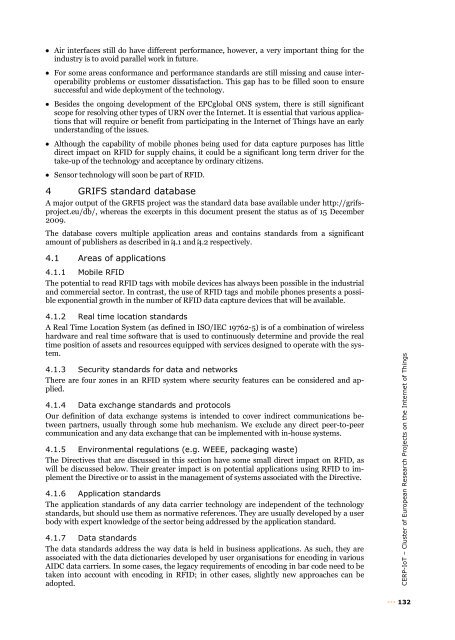Vision and Challenges for Realising the Internet of Things
Vision and Challenges for Realising the Internet of Things
Vision and Challenges for Realising the Internet of Things
Create successful ePaper yourself
Turn your PDF publications into a flip-book with our unique Google optimized e-Paper software.
Air interfaces still do have different per<strong>for</strong>mance, however, a very important thing <strong>for</strong> <strong>the</strong><br />
industry is to avoid parallel work in future.<br />
For some areas con<strong>for</strong>mance <strong>and</strong> per<strong>for</strong>mance st<strong>and</strong>ards are still missing <strong>and</strong> cause interoperability<br />
problems or customer dissatisfaction. This gap has to be filled soon to ensure<br />
successful <strong>and</strong> wide deployment <strong>of</strong> <strong>the</strong> technology.<br />
Besides <strong>the</strong> ongoing development <strong>of</strong> <strong>the</strong> EPCglobal ONS system, <strong>the</strong>re is still significant<br />
scope <strong>for</strong> resolving o<strong>the</strong>r types <strong>of</strong> URN over <strong>the</strong> <strong>Internet</strong>. It is essential that various applications<br />
that will require or benefit from participating in <strong>the</strong> <strong>Internet</strong> <strong>of</strong> <strong>Things</strong> have an early<br />
underst<strong>and</strong>ing <strong>of</strong> <strong>the</strong> issues.<br />
Although <strong>the</strong> capability <strong>of</strong> mobile phones being used <strong>for</strong> data capture purposes has little<br />
direct impact on RFID <strong>for</strong> supply chains, it could be a significant long term driver <strong>for</strong> <strong>the</strong><br />
take-up <strong>of</strong> <strong>the</strong> technology <strong>and</strong> acceptance by ordinary citizens.<br />
Sensor technology will soon be part <strong>of</strong> RFID.<br />
4 GRIFS st<strong>and</strong>ard database<br />
A major output <strong>of</strong> <strong>the</strong> GRFIS project was <strong>the</strong> st<strong>and</strong>ard data base available under http://grifsproject.eu/db/,<br />
whereas <strong>the</strong> excerpts in this document present <strong>the</strong> status as <strong>of</strong> 15 December<br />
2009.<br />
The database covers multiple application areas <strong>and</strong> contains st<strong>and</strong>ards from a significant<br />
amount <strong>of</strong> publishers as described in 4.1 <strong>and</strong> 4.2 respectively.<br />
4.1 Areas <strong>of</strong> applications<br />
4.1.1 Mobile RFID<br />
The potential to read RFID tags with mobile devices has always been possible in <strong>the</strong> industrial<br />
<strong>and</strong> commercial sector. In contrast, <strong>the</strong> use <strong>of</strong> RFID tags <strong>and</strong> mobile phones presents a possible<br />
exponential growth in <strong>the</strong> number <strong>of</strong> RFID data capture devices that will be available.<br />
4.1.2 Real time location st<strong>and</strong>ards<br />
A Real Time Location System (as defined in ISO/IEC 19762-5) is <strong>of</strong> a combination <strong>of</strong> wireless<br />
hardware <strong>and</strong> real time s<strong>of</strong>tware that is used to continuously determine <strong>and</strong> provide <strong>the</strong> real<br />
time position <strong>of</strong> assets <strong>and</strong> resources equipped with services designed to operate with <strong>the</strong> system.<br />
4.1.3 Security st<strong>and</strong>ards <strong>for</strong> data <strong>and</strong> networks<br />
There are four zones in an RFID system where security features can be considered <strong>and</strong> applied.<br />
4.1.4 Data exchange st<strong>and</strong>ards <strong>and</strong> protocols<br />
Our definition <strong>of</strong> data exchange systems is intended to cover indirect communications between<br />
partners, usually through some hub mechanism. We exclude any direct peer-to-peer<br />
communication <strong>and</strong> any data exchange that can be implemented with in-house systems.<br />
4.1.5 Environmental regulations (e.g. WEEE, packaging waste)<br />
The Directives that are discussed in this section have some small direct impact on RFID, as<br />
will be discussed below. Their greater impact is on potential applications using RFID to implement<br />
<strong>the</strong> Directive or to assist in <strong>the</strong> management <strong>of</strong> systems associated with <strong>the</strong> Directive.<br />
4.1.6 Application st<strong>and</strong>ards<br />
The application st<strong>and</strong>ards <strong>of</strong> any data carrier technology are independent <strong>of</strong> <strong>the</strong> technology<br />
st<strong>and</strong>ards, but should use <strong>the</strong>m as normative references. They are usually developed by a user<br />
body with expert knowledge <strong>of</strong> <strong>the</strong> sector being addressed by <strong>the</strong> application st<strong>and</strong>ard.<br />
4.1.7 Data st<strong>and</strong>ards<br />
The data st<strong>and</strong>ards address <strong>the</strong> way data is held in business applications. As such, <strong>the</strong>y are<br />
associated with <strong>the</strong> data dictionaries developed by user organisations <strong>for</strong> encoding in various<br />
AIDC data carriers. In some cases, <strong>the</strong> legacy requirements <strong>of</strong> encoding in bar code need to be<br />
taken into account with encoding in RFID; in o<strong>the</strong>r cases, slightly new approaches can be<br />
adopted.<br />
CERP-IoT – Cluster <strong>of</strong> European Research Projects on <strong>the</strong> <strong>Internet</strong> <strong>of</strong> <strong>Things</strong><br />
132
















